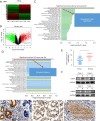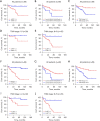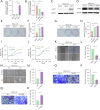Silencing of AJAP1 expression by promoter methylation activates the Wnt/β-catenin signaling pathway to promote tumor proliferation and metastasis in salivary adenoid cystic carcinoma
- PMID: 37441023
- PMCID: PMC10333761
- DOI: 10.21037/gs-23-127
Silencing of AJAP1 expression by promoter methylation activates the Wnt/β-catenin signaling pathway to promote tumor proliferation and metastasis in salivary adenoid cystic carcinoma
Abstract
Background: Salivary adenoid cystic carcinoma (SACC) is a unique malignant tumor of the salivary gland with poor prognosis, which is not effective with chemotherapy and targeted drugs. Therefore, it is important to explore the molecular mechanism underlying SACC invasion and metastasis to develop novel therapeutic strategies and targets in clinical research.
Methods: Real-time quantitative polymerase chain reaction (RT-qPCR) and western blot (WB) were performed to detect the expression of Adherens Junctions Associated Protein 1 (AJAP1). Methylation-specific PCR was used to evaluate the methylation of the AJAP1 promoter. AJAP1 was overexpressed or knocked down by lentivirus-mediated transfection. Kaplan-Meier analysis was conducted to create a survival curve and the log-rank test was used to analyze the overall survival (OS). The prognostic correlation was assessed using univariate and multivariate Cox regression analyses. Co-immunoprecipitation (Co-IP) was utilized to pull down the possible binding protein of AJAP1 and laser scanning confocal microscopy was applied to detect the subcellular localization of AJAP1, E-cadherin, and β-catenin. Cell viability, colony formation, wound healing, and Transwell invasion assays were performed to evaluate the function of AJAP1 in vitro. A subcutaneous xenograft assay in nude mice was performed to verify the function of AJAP1 in vivo.
Results: AJAP1 was downregulated in SACC tumors and was closely related to SACC lymph node/distant metastasis, which was an independent risk factor for SACC prognosis. Methylation-specific PCR confirmed that high methylation of the AJAP1 promoter was the main cause of its silencing. Overexpression or knockdown of AJAP1 in SACC cells could significantly inhibit or promote the proliferation, invasion, and metastasis of SACC cells, respectively, in both the in vitro and in vivo experiments. Mechanically, we found that AJAP1 binds to E-cadherin and β-catenin to form a complex in cytomembrane, reducing the nuclear translocation of β-catenin and blocking the Wingless/Integrated/β-catenin (Wnt/β-catenin) signaling pathway to play a suppressive role in cancer.
Conclusions: In conclusion, these results suggest that the downregulation of AJAP1 protein expression may play a certain role in progression and metastasis of SACC. Our study indicates that AJAP1 may be a potential prognostic molecular marker and therapeutic target for SACC.
Keywords: AJAP1; Salivary adenoid cystic carcinoma (SACC); metastasis; methylation; β-catenin.
2023 Gland Surgery. All rights reserved.
Conflict of interest statement
Conflicts of Interest: All authors have completed the ICMJE uniform disclosure form (available at https://gs.amegroups.com/article/view/10.21037/gs-23-127/coif). The authors have no conflicts of interest to declare.
Figures







Similar articles
-
Claudin-7 Inhibits Proliferation and Metastasis in Salivary Adenoid Cystic Carcinoma Through Wnt/β-Catenin Signaling.Cell Transplant. 2020 Jan-Dec;29:963689720943583. doi: 10.1177/0963689720943583. Cell Transplant. 2020. PMID: 32749148 Free PMC article.
-
NR2F1 contributes to cancer cell dormancy, invasion and metastasis of salivary adenoid cystic carcinoma by activating CXCL12/CXCR4 pathway.BMC Cancer. 2019 Jul 29;19(1):743. doi: 10.1186/s12885-019-5925-5. BMC Cancer. 2019. PMID: 31357956 Free PMC article.
-
LIS1 interacts with CLIP170 to promote tumor growth and metastasis via the Cdc42 signaling pathway in salivary gland adenoid cystic carcinoma.Int J Oncol. 2022 Oct;61(4):129. doi: 10.3892/ijo.2022.5419. Epub 2022 Sep 14. Int J Oncol. 2022. PMID: 36102310 Free PMC article.
-
CCL25/CCR9 interaction promotes the malignant behavior of salivary adenoid cystic carcinoma via the PI3K/AKT signaling pathway.PeerJ. 2022 Aug 19;10:e13844. doi: 10.7717/peerj.13844. eCollection 2022. PeerJ. 2022. PMID: 36003306 Free PMC article.
-
Silencing geranylgeranyltransferase I inhibits the migration and invasion of salivary adenoid cystic carcinoma through RhoA/ROCK1/MLC signaling and suppresses proliferation through cell cycle regulation.Cell Biol Int. 2024 Feb;48(2):174-189. doi: 10.1002/cbin.12096. Epub 2023 Oct 18. Cell Biol Int. 2024. PMID: 37853939
Cited by
-
Endothelial β-catenin upregulation and Y142 phosphorylation drive diabetic angiogenesis via upregulating KDR/HDAC9.Cell Commun Signal. 2024 Mar 15;22(1):182. doi: 10.1186/s12964-024-01566-1. Cell Commun Signal. 2024. PMID: 38491522 Free PMC article.
References
LinkOut - more resources
Full Text Sources
Research Materials
